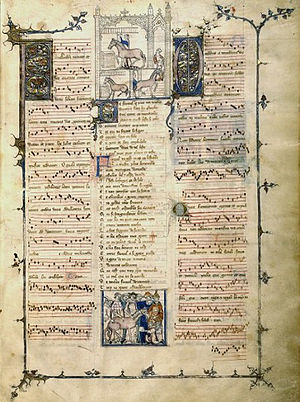الفن الجديد
الفن الجديد (باللاتينية: ars nova) هو مصطلح يستخدم لموسيقى القرن الرابع عشر ليميزه عن القرن الثالث عشر (الفن القديم). في حين كان الموسيقيون في الفن القديم نشطين أساسا في شمالي فرنسا وألمانيا، في الفن الجديد عملوا في جنوبي فرنسا وإيطاليا وشمالي أسبانيا. التقدم الأساسي في الفن الجديد كان استخدام إيقاعات جديدة وهارمونيات تتعلق باستخدام حر للتنافر وطرق معقدة في التدوين الموسيقي. الأسلوب الجديد استخدم في بحثين "موسيقى الفن الجديد" 1325 كتبه المؤلف الموسيقي والشاعر والدبلوماسي الفرنسي فيليپ دى ڤيتري وكتاب آخر بنفس العنوان للدارس يوهانس دى موريس. أهم مؤلف فرنسي للفن الجديد هو گييوم دو ماشو في منتصف القرن الرابع عشر، الذي اضافة لتأليف الموتيت كان أول مؤلف موسيقي يكتب تلحين پوليفوني لقداس كامل. ماشو أيضا ألـّف الپالاد والروندو والڤيرلاي Virelai، وهي كلها أغنيات دنيوية پوليفونية. المؤلفون الإيطاليون الأساسيون للنصف الأول من القرن الرابع عشر كانوا جوڤاني دا كاشيا وجاكوپو دا بولونيا، الذين كتبوا أساساً في صيغة المادريگال والكاشيا؛ أعظم مؤلف في النصف الثاني من القرن الرابع عشر هو فرانشسكو لانديني الذي فضل البالاتا Ballata وهي النسخة الإيطالية من الڤيرلاي Virelai الفرنسي.[2]
. . . . . . . . . . . . . . . . . . . . . . . . . . . . . . . . . . . . . . . . . . . . . . . . . . . . . . . . . . . . . . . . . . . . . . . . . . . . . . . . . . . . . . . . . . . . . . . . . . . . . . . . . . . . . . . . . . . . . . . . . . . . . . . . . . . . . . . . . . . . . . . . . . . . . . . . . . . . . . . . . . . . . . . .
تسجيلات
- Chants du xivème siècle. Mora Vocis Ensemble. France: Mandala, 1999. CD recording MAN 4946.
- Denkmäler alter Musik aus dem Codex Reina (14./15. Jh.). Syntagma Musicum (Kees Otten, dir.). Das Alte Werk. [N.p.]: Telefunken, 1979. LP recording 6.42357.
- Domna. Esther Lamandier, voice, harp, and portative organ. Paris: Alienor, 1987. CD recording AL 1019.
- La fontaine amoureuse: Poetry and Music of Guillaume de Machaut. Music for a While, with Tom Klunis, narrator. Berkeley: 1750 Arch Records, 1977. LP recording 1773.
- گييوم دو ماشو. Je, Guillaumes Dessus Nommez. Ensemble Gilles Binchois (Dominique Vellard, dir.). [N.p.]: Cantus, 2003. CD recording 9804.
- گييوم دو ماشو. La Messe de Nostre Dame und Motetten. James Bowman, Tom Sutcliffe, countertenors; Capella Antiqua München (Konrad Ruhland, dir.). Das Alte Werk. Hamburg: Telefunken, 1970. LP recording 6.41125 AS.
- گييوم دو ماشو. La messe de Nostre Dame; Le voir dit. Oxford Camerata (Jeremy Summerly, dir.). Hong Kong: Naxos, 2004. CD recording 8553833.
- گييوم دو ماشو. Messe de Notre Dame. Ensemble Organum (Marcel Pérès, dir.). Arles: Harmonia Mundi, 1997. CD recording 901590.
- گييوم دو ماشو. Messe de Notre Dame; Le lai de la fonteinne; Ma fin est mon commencement. Hilliard Ensemble (Paul Hillier, dir.). London: Hyperion, 1989.
- Guillaume de Machaut. Motets. Hilliard Ensemble. Munich: ECM Records, 2004.
- فيليپ دى ڤيتري and the Ars Nova—Motets. Orlando Consort. Wotton-Under-Edge, Glos., England: Amon Ra, 1990. CD recording CD-SAR 49.
- فيليپ دى ڤيتري. Motets & Chansons. Sequentia (Benjamin Bagby and Barbara Thornton, dir.) Freiburg: Deutsche Harmonia Mundi, 1991. CD recording 77095-2-RC.
- Roman de Fauvel. Jean Bollery (speaker), Studio der Frühen Musik (Thomas Binkley, dir.). Reflexe: Stationen europäischer Musik. Cologne: EMI, 1972. LP recording 1C 063-30 103.
- Le roman de Fauvel. Anne Azéma (soprano, narration), Dominique Visse (countertenor, narration), Boston Camerata and Ensemble Project Ars Nova (Joel Cohen, dir.). France: Erato, 1995. CD recording 4509-96392-2.
- The Service of Venus and Mars: Music for the Knights of the Garter, 1340–1440. Gothic Voices (Christopher Page, dir.). London: Hyperion, 1987. CD recording CDA 66238.
- The Spirit of England and France I: Music of the Late Middle Ages for Court and Church. Gothic Voices (Christopher Page, dir.). London: Hyperion Records, 1994. CD recording CDA66739.
- The Study of Love: French Songs and Motets of the 14th Century. Gothic Voices (Christopher Page, dir.). London: Hyperion Records, 1992. CD recording CDA66619.
هوامش
مراجع وللاستزادة
- [بحاجة لمصدر] (1980). "Ars nova". The New Grove Dictionary of Music and Musicians, edited by Stanley Sadie. 20 vols. London: Macmillan Publishers Ltd. ISBN 1-56159-174-2
- Earp, Lawrence (1995). "Ars nova". In Medieval France: An Encyclopedia, edited by William W. Kibler, Grover A. Zinn, Lawrence Earp, and John Bell Henneman, Jr., 72–73. Garland Reference Library of the Humanities 932; Garland Encyclopedias of the Middle Ages 2. New York: Garland Publishers. ISBN 978-0-8240-4444-2.
- Fallows, David. (2001). "Ars nova". The New Grove Dictionary of Music and Musicians, second edition, edited by Stanley Sadie and John Tyrrell. London: Macmillan Publishers.
- Fuller, Sarah (1985–86). "A Phantom Treatise of the Fourteenth Century? The Ars Nova". The Journal of Musicology 4, no. 1 (Winter): 23–50.
- Gleason, Harold, and Warren Becker (1986). Music in the Middle Ages and Renaissance. Music Literature Outlines Series 1. Bloomington, Indiana: Frangipani Press. ISBN 0-89917-034-X
- Hoppin, Richard H. (1978). Medieval Music. New York: W. W. Norton & Co. ISBN 0-393-09090-6
- Leech-Wilkinson, Daniel (1990). "Ars Antiqua—Ars Nova—Ars Subtilior". In Antiquity and the Middle Ages: From Ancient Greece to the 15th Century, edited by James McKinnon, 218–40. Man and Music. London: Macmillan Publishers. ISBN 0-333-51040-2 (cased); ISBN 0-333-53004-7 (pbk).
- Schrade, Leo (1956). "Philippe de Vitry: Some New Discoveries". The Musical Quarterly 42, no. 3 (July): 330–54.
- Snellings, Dirk (2003). "Ars Nova and Trecento Music in 14th Century Europe" (retrieved on 2008-06-14), translated by Stratton Bull, 12. CD Booklet CAPI 2003.
